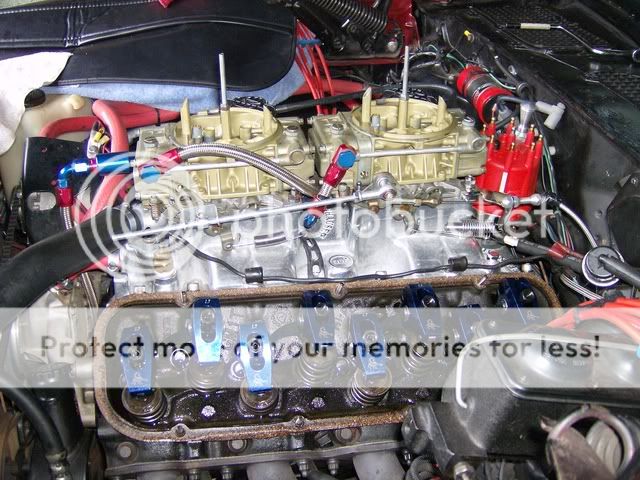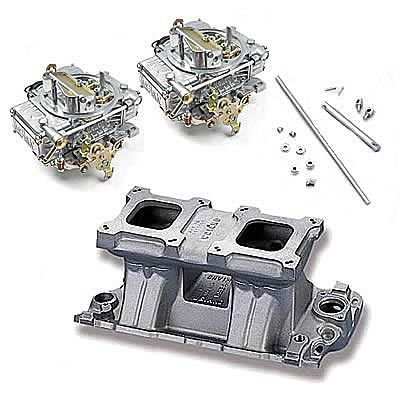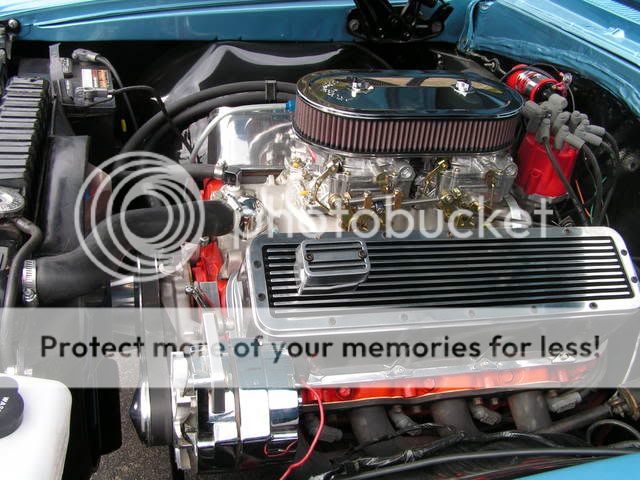it can be made to run reasonably well, YES!
will it be impressive SURE IT WILL!
but gas mileage usually suffers, and your unlikely to have the instant response, to part throttle operation that the more traditional low rise dual quads with progressive linkage provide.
but a tunnel ram intake will never be really practical or useful on the street, as anything but an impressive looking intake to impress your buddies due to the fact that the basic tunnel ram intake design is really made to produce its best power curve in the 4500rpm-7000rpm range, with the throttle held to the floor and the carbs wide open, with a cam that got a good deal of duration and overlap, and the matching high compression, (at least 11:1) and rear gear ratios in the 4.11-to-5.13:1 range
now you can run dual quads with progressive linkage and get excellent results
now if your being honest youll admit that you spend a good deal more time under 4500rpm, at part throttle than over 4500rpm with your foot firmly against the floor
http://www.allcarbs.com/detail.php?pid= ... n=71&stt=0
viewtopic.php?f=55&t=444&p=5682&hilit=+dual+quads#p5682
Ive run several different tunnel ram combos (mostly on 454-540 BBC engines ) but also on a 396 BBC and once you get good at reading plugs and adjusting carbs youll do fine, Ive usually seen guys go crazy when they try to adjust the dual quads like they might on a low rise where each of the 4 pairs of venturies open in progressive order,
TUNNEL RAMS HATE THAT B.S.both the front and rear carbs need to be perfectly syncronized,duplicating each others movements exactly, linkage needs to be smooth and tested so it won,t bind or jam, and you need a full 5.5 psi of fuel pressure at the carbs and a decent return flow fuel pressure regulator, and keep in mind the intake design works best at full wide open throttle with all 8 venturies set up to provide the same jetting and flow in many case,its not really designed to cruise around at 2500rpm, and its not designed for mileage,its never going to be the ideal street combo, its designed to provide massive, and smoothly increasing hp/tq from about 4500rpm-7500rpm , CONSISTANCY is important, and its a system that demands a long high volume accellerator pump shot to cover the transition from part to WOT.
http://victorylibrary.com/mopar/intake-tech-c.htm
viewtopic.php?f=50&t=383
http://store.summitracing.com/partdetai ... toview=sku
viewtopic.php?f=70&t=202&p=702&hilit=sparkplugs#p702
YOU DON,T SET THE THROTTLE LINKAGE UP OR TUNE A TYPICAL LOW RISE DUAL QUADS LIKE A TUNNEL RAM IS SET UP OR TUNED, on the low rise dual quads many guys have the rear carb primairies open about 1/4 before the front carb primairys start to open and the rear secondaries open before the front secondaries do, thats all wrong on a tunnel ram,
transition, means that few instants between holding it at about 2000rpm just before your launch and rapidly depressing the pedal to WOT,and the engines running up close to the rev limiter, in a few heart beats, tunnel rams are MAX EFFORT intakes, and not really designed for a daily driver BUT if your good at tuning youll get by on the street remarkably well
but this may help you
http://users.erols.com/srweiss/calcdchg.htm
http://users.erols.com/srweiss/calccarb.htm
viewtopic.php?f=44&t=621
http://users.erols.com/srweiss/calcafhp.htm
http://www.rbracing-rsr.com/runnertorquecalc.html
http://victorylibrary.com/mopar/intake-tech-c.htm
http://www.geocities.com/MotorCity/T...92/vizard.html
http://www.bob2000.com/carb.htm
http://www.mortec.com/carbtip1.htm
http://www.rbracing-rsr.com/runnertorquecalc.html
http://www.centuryperformance.com/vacuum.asp
the question usually goes " what size carb do I need," or something similar,
4v carbs are rated at a flow rate determined with a vacume or pressure drop of 1.5" of mercury, your best power AT WIDE OPEN THROTTLE AT MAX RPMS will generally be found with a carb that lowers the presure drop or vacume to between 0.5" and 1.0" of vacume, not 1.5" at full throttle,more vacume at full throttle indicates a slight restriction to flow, now on a street car thats not going to be much if and problem, but on a race cars engine its a sign that your potentially giving away some potential power.
lets look at your comon 600cfm carb some of you guys use, a 0.5 inches of vacume it flows only about 350cfm, at 1.0" it flows about 500cfm, at 1.5" it flows about 600 cfm , rated like a two barrel at 3.0" of vacume it flows close to 780cfm, and if you stuck it on a 600 cubic inch big block spinning 6000rpm youll pull about 6" of vacume and it would flow about 1000cfm plus!
now remember youll try to stay in the .5" to 1.5" range at full throttle, to make good power.
now some of you might notice that the flow dropped NOTICABLY once the vacume dropped and dropping the vacume at wide open throttle tends to help power, provided the a/f ratio is kept near 12.7-13.0:1,AND the engine is set up to USE the flow available to it.
VOLUMETRIC EFFICIENCY
in theory a cylinder fills to 100% full, but the limited time the valves are open and the ports restrictive flow will only allow that to happen at a narrow rpm range
your engines torque curve on an rpm scale closely mirrors the engines efficincy at filling the cylinders, on that same scale, once the cam timing and port flow become a restriction power falls off because theres less fuel /air mix burnt per power stroke, the power tends to keep going up for alittle further in the rpm band simply because theres MORE ,thou slightly less effective power strokes per minute.
at 1000rpm theres 500 intake strokes per minute thats 8 per second times the intake valve opens and closes, at 6500rpm thats 54 times a second, not much time when you think about what needs to flow thru that port in the limited time....especially if you remember that of that 720 degrees in the cycle only about 240 degrees have any useful flow potential, so you just cut even that time by 2/3rds
some of you may have figgured out that to get the lower vacume or restriction, youll want a larger carb or perhaps two carbs, remember were trying to get that .5"-1.0" of vacume at full throttle, and that 600cfm carb is not going to flow 600cfm, at that vacume reading but between about 350-500cfm, so if you have an engine that can take full advantage of the flow it may, and usually does require a larger carb to make max power,that 383 might require an 800-850cfm carb or two 600 cfm carbs (since you double the venturie cross sectional area with two carbs the vacume reading is generally cut to about 1/2 what it was and the two 600 cfm carbs now flow about 350cfm each or 700cfm per pair) yet the carb size is just NOT all that critical,to making fairly decent (NOT MAXIMUM POWER) simply because as the vacume signal goes up, so does the carbs flow rate, and as the vacume signal strength goes down so does the flow
RESPONCE!
up till now we are talking only FULL THROTTLE POWER, but you operate under a wide range of rpms and loads, put that larger carb on a small engine and it makes good power at wide open throttle, but it also tends to have a weak vacume signal at off idle rpm ranges and it may run like crap! so a ballance must be accepted. smaller carbs are generally more responsive, but slightly more restrictive with thier smaller venturies.
http://www.carcraft.com/techarticles/03 ... index.html
http://www.superchevy.com/technical/eng ... index.html



